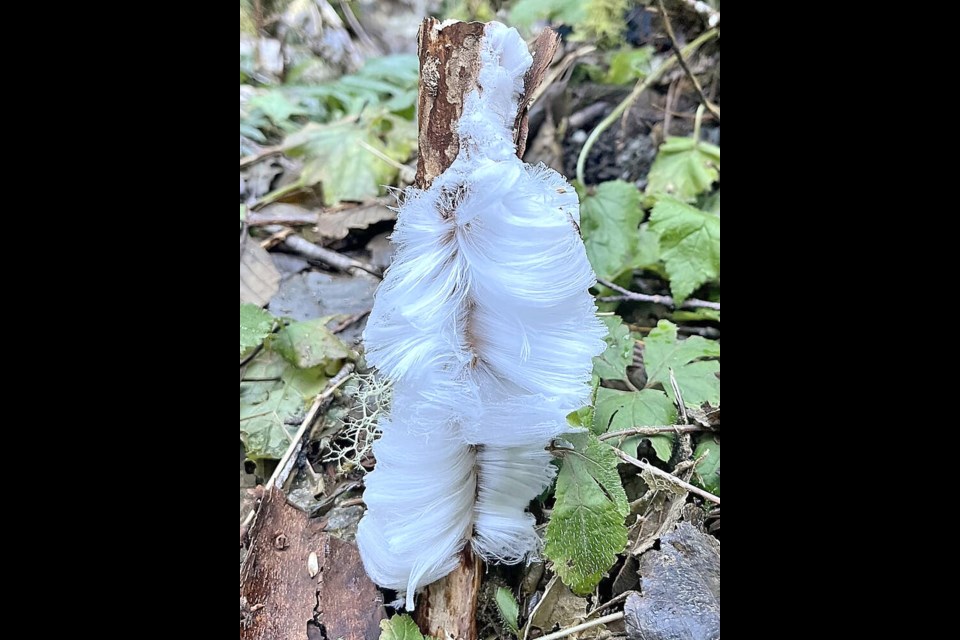Avid hikers Sandra Meyer and Rayto Robinson thought they had seen it all.
They had witnessed majestic Roosevelt elk in the San Juan Valley near Port Renfrew and walked up to the base of the Red Creek Fir, the tallest Douglas fir tree in Canada, piercing the sky at 70 metres.
But it was the weird and wonderful white thing they noticed among the undergrowth and salal while out for a hike that really blew their minds.
“It was like something out of Narnia,” said Meyer, a secretary for School District 62. “[We thought] is this us being crazy or this something that’s super cool?”
It was cool. Ice cold, in fact.
What the couple saw on the forest floor was the rare phenomenon of hair ice, which forms from a combination of moisture, slightly sub-zero temperatures and a specific type of fungus associated with dead wood.
The intricate ice formations, also called ice wool and frost beard, look like smooth, silky hairs. The formations can also resemble cotton candy and protrude upright like chimney smoke in puffy bunches, as seen in recent photos from Washington state.
Mushroom expert Kem Luther, who co-authored the Royal British Columbia Museum field guide Mushrooms of British Columbia, said Meyer’s is one of the best examples he’s seen.
“Many people mistake hair ice, when they first see it, for some kind of fungus. They are not totally wrong. A fungus is involved,” said Luther.
It’s the Exidiopsis effusa fungus, which lives on dead wood, that produces hair ice formations in cool, moist conditions.
Luther said meteorologist Alfred Wegener, discoverer of continental drift, described hair ice on wet deadwood in 1918, and “prophetically assumed that some fungus was the catalyst.”
In 2015, he said, the white crustose fungus Exidiopsis effusa was identified by German and Swiss researchers as the key to the formation of hair ice. The fungus helps to shape the ice into fine hairs and stabilizes the ice formation by providing a sort of antifreeze. Without the fungus, researchers found, the ice expelled by the wood just forms an ice crust.
According to information on the German and Swiss research at the Ultimate Mushroom website, the presence of the fungus leads to a process called ice segregation. When water in the wood freezes, it creates a barrier that traps liquid between the ice and the pores of the wood, which creates suction that pushes the water out of the pores to the edge of the ice surface, where it freezes and extends outwards. As the process repeats, it pushes thin hairs of ice out of the wood.
Luther said hair ice is ephemeral—it disappears within a few hours. But it will emerge from the same piece of wood year after year.
For hair ice to appear, conditions must be just right, he said. It only forms in broad leaf and mixed-wood forests around the world between 45° and 55° north latitudes, and only when temperatures are slightly below freezing and the air is humid.
Meyer said they were hiking in conditions at about freezing — skims of ice had formed on the logging-road potholes. “It was cold but there wasn’t any snow,” she said, which is what made the ice formation stick out.
“It was just sitting there, and it felt cold [to touch],” said Meyer. “Just amazing.”
Luther said the weather in Greater Victoria was just right in the winter of 2019, when hair ice was last reported.
The Exidiopsis effusa species used in the 2015 research has not been identified in British Columbia, he said, but the province has “several other Exidiopsis species and we have hair ice, so some other species may be involved.”
>>> To comment on this article, write a letter to the editor: [email protected]



